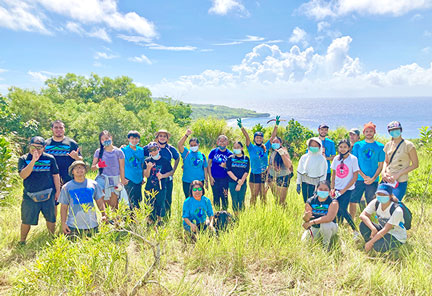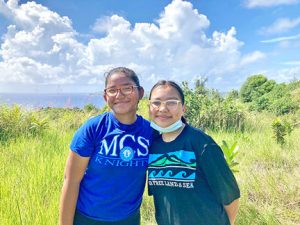Schools for Environmental Conservation

Over the past two Saturdays, students and teachers from Saipan Community School, Saipan International School, Mount Carmel School, Hopwood Middle School, and Dandan Middle School hiked a half a mile stretch through the forest to get immersed on environmental conservation efforts in LaoLao’s upper badlands, revegetation, fire hazard mitigation, and watershed management.
The out-of-the box activity is part of the Schools for Environmental Conservation program of the Micronesia Islands Nature Alliance, for the youth to actually connect with nature, and gain hands-on experience that will equip them to be effective and strong environmental stewards, especially here in the CNMI.
Schools on island have been running conservation programs in their own campuses, and MINA has been helping them realize environmental plans that they have yet to implement, through guidance, funding assistance, and through on-the-ground experiences that students would be able to learn from.
Dandan Middle School, for one, already grows plants and are doing aquaponics in their school, but still have joined the program to help even more. STEM teacher James Montenegro shares that they are a part of the project to highlight the importance of having every single generation know how to take care of the island.
And so, hiking through the forest, the young minds were introduced to invasive plant species, as they were treated to a rundown on the role trees and native plants play in keeping the island’s ecosystem intact, keeping everyone safe.

“Pay attention to your surroundings,” MCS’ Mercedes Cruz, one of the students involved in the program, said. “It’s really important since we are the new generation that’s going to be in this world. We need to pay attention, to care for it, since it’s mainly what’s keeping us alive.”
This year, the program is focused on climate change, marine protected areas, conservation of Saipan’s priority watershed, and coral reefs, given that the health of the CNMI’s natural resources continue to be threatened. The theme, “Learning about, Interacting with, and Actively Conserving Our Natural Resources.”
Revegetation and the future
Revegetating our forests is key to stabilizing CNMI soils, in protecting the watershed, and in securing the future of the islands. Division of Coastal Resources Management watershed coordinator Zachary Williams talked about how deforestation and the influx of invasive species had impacted the island, particularly in not being always as good at holding soil, which leads to erosion and runoff.
“If you don’t have plans to stabilize the soils, they will get washed down on the reef, and they’ll end up smothering and killing the reef. Reefs are very fragile. The best thing for watershed is to have native species, like a whole native forest.”
“Due to this, as much as we can, we are trying to move towards revegetation of native species, such as what is going on now in LaoLao. There’s a big revegetation project on Rota too, as well as some planned projects in Achugao. We are really trying to, as much as we can, re-establish native forests, especially the native, limestone forest here on Saipan.”
MINA’s Schools for Environmental Conservation program have students planting da’ok trees, provided by CNMI Forestry, in an effort to revegetate the upper badland in LaoLao. MINA has been leading the effort for native revegetation on the island for years.
“One of the best things we can do is to help facilitate native revegetation, which is what we’re doing up here… We need to give our native species a helping hand, and one way we can do that is by planting open areas or recently disturbed areas like up here like this grassland spot.”
Williams explains that in so doing, the students (and other volunteers) could help facilitate “succession,” a process wherein species get planted to form up micro habitats, which would help bring in other species that will develop into a midsize forest, and then finally, the climax forests with larger tree species.
“Through revegetation, we’re trying to help facilitate the process of succession, and establishment of a native forests… We’ve seen some great survival rate and these plants have grown quite a bit… We’re starting to see not just growth of the native species that we planted, but other species come in on their own, which is a great sign that we’re doing a good job in creating a healthy native ecosystem.”
And playing a big role in these revegetation projects mean a lot for young people here in the CNMI.
“This vegetation project is important for younger generations, because a lot of us don’t really know what the importance of the plants are to us… They provide us a lot of oxygen nutrients and it’s really important to keep them healthy, in order to have a good environment,” MCS’ Tyana Tesiro said.
Students protecting the reefs
Revegetation projects, such as what the students did over the last two Saturdays, not only protect the terrestrial ecosystems, but ultimately, the marine environment. Protecting upland habitat and stabilizing soil, in the long run, protects the reef, by keeping dirt from washing down to the ocean.
But, aside from the need for invasive species, there’s another element affecting our forests—fire.
“On Saipan, the fuel is often coming from grasses that end up in the dry season getting exceedingly dry, and then it carries a fire throughout the entirety of the grassland until it reaches the edges of the forest,” NOAA fellow Ilan Bubb explains to the students.
“If a fire breaks out, they burn out all this grass and just leave you with this bare soil. And as soon as the rain comes on, that soil is going to slough right off the land and end up in the coral. Fires are just another way that you create bare soil that creates more erosion, which is really problematic for all the ecosystems that we rely on.”
Bubb emphasizes that the main thing the students can do to help is to help prevent the fires from actually starting, which includes being safe with fires, asking parents not throwing cigarettes out, or helping revegetate grasslands with trees.
Without vegetated areas trapping sediments, soil gets washed out, down to the reef, where huge sediment plumes could lead to coral lost. Everything is interconnected. Corals get most of their food from photosynthesis, and will starve to death if they can’t get sunlight.
Supporting active conservation
What started as an Environmental Teacher Camp in 2007 has expanded into Schools for Environmental Conservation, a full program where both students and teachers together engage in educational and field activities for the environment.
MINA program director Becky Furey shares that the provides opportunities for schools to learn about and work on a project that focuses on a specific environmental issue, and the non-profit provides the technical and financial assistance to turn the schools’ environmental projects into action.
“Through experiential learning from these natural laboratories, SFEC students and teachers will not only realize the critical role that the CNMI’s natural resources play in the islands’ sustainability but also promote and encourage environmental stewardship throughout the islands.”
“If you’d like to support MINA’s efforts in empowering communities for conservation, please visit www.minapacific.org to make a voluntary contribution,” Furey adds. Funding for this year’s program is through the Micronesia Conservation Trust.
Aside from providing experiential learning, MINA also hopes the program will encourage students to pursue careers in environmental science, and to be ambassadors promoting biodiversity, environmental conservation, and sustainable living, that will secure an even better Marianas in the decades to come.
Dandan Middle School’s teacher James Montenegro couldn’t have said it better, “You really can’t plan for the future if you don’t prepare for now… So, by preparing for it now, we protect our future. We have to train the children to be able to do that with each generation.”
To learn more about the program, contact MINA at 233-7333 (REEF) or visit https://www.minapacific.org.




